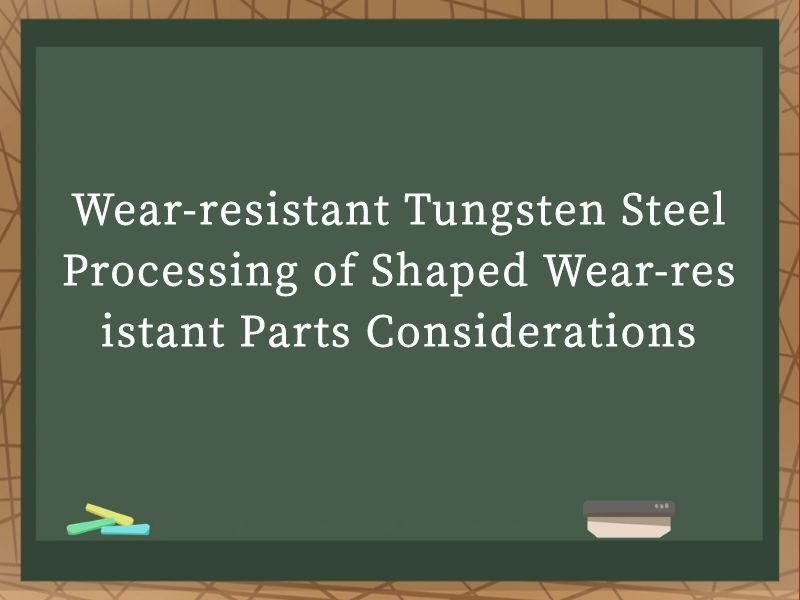JOURNALISM
- NEWS -
|
|
Wear-resistant Tungsten Steel Processing of Shaped Wear-resistant Parts ConsiderationsWear-resistant Tungsten Steel Processing of Shaped Wear-resistant Parts Considerations.Tungsten steel, renowned for its exceptional hardness and wear resistance, has become a preferred material for manufacturing shaped wear-resistant parts in various industries. The processing of tungsten steel, however, presents unique challenges due to its hardness and specific material properties. This article delves into the considerations involved in the processing of tungsten steel for shaped wear-resistant parts, focusing on material selection, machining techniques, heat treatment, and surface treatments.
Material Selection Tungsten steel, also known as tungsten carbide or cemented carbide, is a composite material consisting of tungsten carbide particles bonded together by a metallic binder, typically cobalt. Its hardness, wear resistance, and ability to maintain a cutting edge make it ideal for tooling and wear parts. When selecting tungsten steel for shaped wear-resistant parts, it's crucial to consider the specific application requirements. Factors such as the expected load, operating temperature, and the presence of corrosive environments all influence the choice of tungsten steel grade. Machining Techniques Machining tungsten steel can be challenging due to its hardness. Traditional machining methods like milling, turning, and grinding require specialized tools and cutters designed to withstand the rigors of cutting through hard materials. The use of high-speed steel (HSS) or carbide tools is recommended, and the cutting parameters (speed, feed rate, and depth of cut) must be carefully adjusted to prevent tool breakage and ensure part accuracy. Advanced machining techniques, such as electrical discharge machining (EDM) or wire electrical discharge machining (WEDM), can be effective for creating complex shapes in tungsten steel. These methods utilize electrical discharges to erode material, allowing for precise and intricate cuts. Heat Treatment Tungsten steel parts often undergo heat treatment to further enhance their mechanical properties. However, due to the material's hardness and the presence of carbide particles, special care must be taken during the heat treatment process. Annealing, for instance, can be used to soften the material prior to machining, making it easier to shape. Hardening and tempering cycles can then be applied to restore hardness and improve wear resistance. It's important to note that improper heat treatment can lead to cracking or distortion of the part, especially if the heating and cooling rates are not controlled properly. Therefore, it is advisable to consult with a materials engineer or metallurgist to determine the optimal heat treatment parameters for the specific tungsten steel grade being used. Surface Treatments To further enhance the wear resistance of tungsten steel parts, various surface treatments can be applied. Coatings such as titanium nitride (TiN) or chromium nitride (CrN) can be deposited on the surface to increase hardness and reduce friction. These coatings are typically applied using physical vapor deposition (PVD) or chemical vapor deposition (CVD) techniques. In addition, surface grinding or polishing can be used to achieve the desired surface finish and remove any imperfections that may have occurred during machining. It's crucial to select the appropriate abrasive materials and grinding/polishing parameters to avoid damaging the tungsten steel surface. Quality Control Quality control is essential in the manufacturing of tungsten steel parts. Regular inspection and testing should be conducted to ensure that the parts meet the required specifications. Non-destructive testing methods, such as ultrasonic inspection or magnetic particle inspection, can be used to detect internal flaws or cracks. Dimensional accuracy and surface finish should also be checked using precision measuring instruments. Processing wear-resistant tungsten steel for shaped parts requires careful consideration of material selection, machining techniques, heat treatment, surface treatments, and quality control. Each step in the manufacturing process must be carefully planned and executed to ensure the production of high-quality, durable parts. By understanding the unique properties of tungsten steel and the challenges associated with machining hard materials, manufacturers can effectively produce shaped wear-resistant parts that meet the demands of various industrial applications. |


